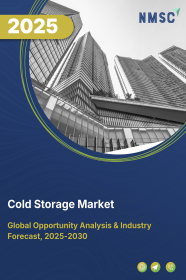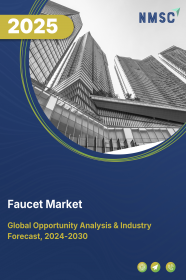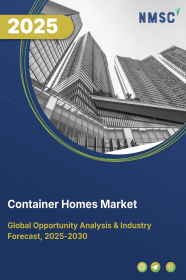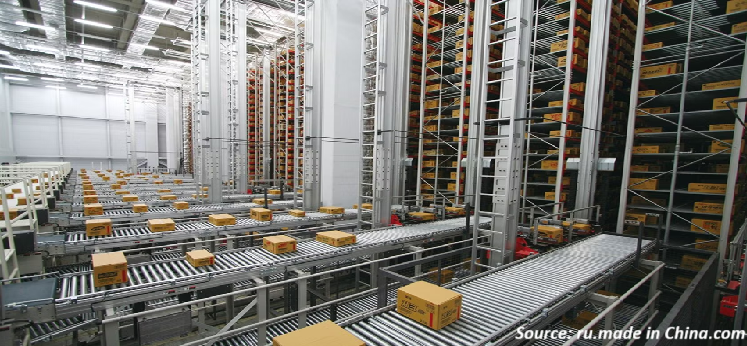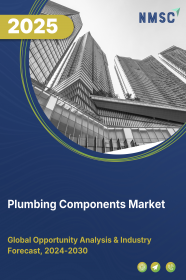
Plumbing Components Market by Products (Pipes and Tubes, Valves, Fittings, Manifolds, and Others), by Application (Bathtubs, Showerheads, Faucets, and Other), and by End Users (Residential, and Non-Residential) – Global Opportunity Analysis and Industry Forecast 2025-2030
US Tariff Impact on Plumbing Components Market
Trump Tariffs Are Reshaping Global Business
Plumbing Components Market Overview
The global Plumbing Components Market size was valued at USD 83.90 billion in 2024 and is predicted to reach USD 116.33 billion by 2030 with a CAGR of 5.6% from 2025-2030. The market is currently experiencing a dynamic phase, shaped by key market trends such as a growing emphasis on sustainable plumbing solutions, the increasing integration of smart plumbing technologies, and continuous advancements in plumbing materials and techniques.
Several factors are driving the market growth, notably the rising demand for sustainable and eco-friendly options, ongoing urbanisation and infrastructure development, particularly in emerging economies, and the relentless pace of technological innovation in plumbing systems.
However, the market also faces restraints and challenges, including competition from alternative piping materials and a persistent shortage of skilled plumbing labour. Despite these challenges, significant opportunities exist for industry players through expansion into burgeoning emerging markets and by capitalising on the need for retrofitting and upgrading existing plumbing infrastructure with more efficient and sustainable components. The overall industry size and growth potential of the plumbing component sector are substantial, driven by these interconnected factors influencing both residential and commercial segments.
The Surging Demand for Sustainable Plumbing Solutions Boosts the Plumbing Components Market Growth
The market is significantly propelled by the escalating demand for sustainable and eco-friendly plumbing solutions. This shift is underpinned by increasing environmental awareness among consumers and stricter regulatory requirements pushing for water conservation and energy efficiency. For instance, the growing popularity of low-flow fixtures like toilets and faucets, greywater recycling systems, and water-efficient appliances demonstrates this trend.
Furthermore, manufacturers are focusing on the sustainability quotient of their products by using recyclable materials and adopting eco-friendly manufacturing processes. This demand not only addresses environmental concerns but also offers long-term cost savings for end-users through reduced water and energy consumption. The market share of sustainable plumbing components is steadily increasing, indicating a strong growth potential in this segment.
Urbanisation and Infrastructure Development Propels the Demand for Plumbing Components
Another crucial driving factor for the plumbing component market demand is the continuous urbanisation and the subsequent need for robust infrastructure development, especially evident in emerging economies. As more people migrate to urban centres, the demand for new residential, commercial, and industrial buildings surges, necessitating the installation of comprehensive plumbing systems. This is particularly true in the Asia-Pacific region, including countries like China and India, where the booming construction industry is a major catalyst for the market growth.
Similarly, infrastructure projects related to water supply, sewerage, and drainage systems require vast quantities of pipes, fittings, and other plumbing components. The market size for plumbing solutions in these developing regions presents significant growth opportunities as infrastructure investments continue to rise.
Technological Advancements in Plumbing Component Accelerates the Market Growth
The plumbing component sector is also being significantly driven by continuous technological advancements and innovation. This includes the development of smart plumbing systems with features like remote monitoring, leak detection, and automated controls.
The integration of IoT (Internet of Things) devices for monitoring water usage and quality is gaining traction. Furthermore, innovations in plumbing materials, such as the increasing use of PEX piping for its flexibility and ease of installation and the development of no-leak, no-clog technologies, are enhancing the efficiency and longevity of plumbing systems.
The adoption of press-connect fittings offers faster and safer installation methods compared to traditional soldering. These technological leaps are improving the performance, convenience, and sustainability of plumbing systems, thereby fuelling market growth and creating opportunities for companies that embrace these advancements.
Competition from Alternative Piping Hinders the Plumbing Components Market Expansion
A significant restraint in the market is the intense competition from alternative piping materials such as copper, stainless steel, and traditional PVC. Each material possesses unique properties and cost considerations that appeal to different applications and preferences.
For example, copper pipes are known for their durability and resistance to bacteria, while PVC pipes are affordable and easy to install. The emergence and increasing adoption of newer materials like PPR (Polypropylene Random Copolymer) pipes, known for their eco-friendly nature, and HDPE (High-Density Polyethylene) pipes, valued for their durability and recyclability in infrastructure projects, further intensifies this competition.
Manufacturers of specific plumbing components must continuously innovate and offer cost-effective solutions to maintain and grow their market share amidst this diverse landscape of material options.
Retrofitting and Upgrading Existing Plumbing Infrastructure Creates Future Opportunities for the Market Growth
A significant opportunity for key players in the plumbing component market lies in the increasing need for retrofitting and upgrading existing plumbing infrastructure. Many older residential and commercial buildings still utilise outdated and inefficient plumbing systems, leading to water wastage, higher energy consumption, and potential maintenance issues.
Regis Saragosti, CEO of SFA Saniflo North America, notes that retrofitting existing systems will offer plumbing contractors’ opportunities in 2024 to upgrade these systems with sustainable solutions. This includes replacing old pipes with more durable and efficient materials like PEX or copper, installing water-saving fixtures, and integrating smart plumbing technologies for better monitoring and control.
The sheer volume of existing buildings requiring upgrades presents a substantial market for plumbing components, offering significant growth potential for manufacturers and installers who provide cost-effective and efficient solutions for modernising plumbing infrastructure.
For instance, in January 2025, SFA Saniflo North America expanded its product line with the launch of the Saniflo Connected app, enabling remote monitoring and diagnostics of macerating and grinding pump systems. This innovation aligns with the retrofitting trend by offering contractors and building managers smart, efficient solutions to upgrade existing plumbing infrastructure. The vast number of buildings requiring upgrades, combined with such advancements, creates significant growth potential for manufacturers and installers delivering sustainable, high-performance solutions.
Market Segmentation and Scope of the Study
The plumbing components market report is divided on the basis of products, applications, end user and region. On the basis of products, the market is categorized into pipes and tubes, valves, fittings, manifolds, and others. On the basis of applications, the market is segmented into bathtubs, showerheads, faucets, and others. On the basis of end users, the market is bifurcated into residential and non-residential. Regional breakdown and analysis of each of the aforesaid segments includes regions comprising of North America, Europe, Asia-Pacific, and RoW.
Geographical Analysis
In Asia-Pacific, the plumbing component market share is experiencing significant expansion, largely fuelled by rapid urbanisation and extensive infrastructure development, particularly within emerging economies like China and India. This region currently holds a considerable market share in the global PPR pipe market, with booming construction activities driving substantial demand in both residential and commercial projects.
Furthermore, other emerging markets within Asia-Pacific are also contributing to this upward trajectory as they witness economic advancement and increased investments in foundational infrastructure. The Indian plumbing industry, for example, is a rapidly growing sector capitalising on a large population and increasing needs for improved sanitation and water systems. Companies like Prince Pipes are key players in this dynamic Indian market.
North America represents a mature yet still evolving market for plumbing components. The plumbing services industry in the U.S. is substantial, generating significant annual revenue through installation, repairs, and maintenance. The plumbing fixtures sector in North America is also projected to experience a healthy compound annual growth rate, driven partly by the increasing number of aging homes and buildings requiring repair and upkeep. There's a growing interest in eco-friendly plumbing products and practices, such as low-flow fixtures and greywater recycling systems.
Moreover, workforce factors, particularly the shortage of skilled labour, are influencing the adoption of technologies that allow for faster installation, such as press-connect fittings, which also align with growing environmental consciousness. However, the region is also susceptible to global supply chain disruptions, given its reliance on overseas goods.
The Europe market for plumbing components is characterised by a focus on durability and advanced solutions. While the sources provide less specific detail on the region’s overall market size, there are examples of innovation and specific product applications.
For instance, a Swiss subsidiary, Straub, specialising in precision metal couplings, secured a significant order in 2023 from Eurotunnel, demonstrating the demand for robust and reliable plumbing solutions even in critical infrastructure projects. The emphasis on sustainability and efficiency, similar to North America, is likely a key market trend in many European countries, influencing the demand for advanced plumbing materials and technologies.
Finally, the Rest of the World encompasses a diverse range of markets with varying levels of development. Emerging markets in regions such as the Middle East, Africa, and Latin America are displaying a surge in demand for plumbing components, particularly PPR pipes, as these areas experience economic development and increased investment in their infrastructure. These regions present considerable growth potential for manufacturers looking to expand their global footprint. Overall, the global plumbing component market is shaped by these distinct regional dynamics, each with its own set of drivers, trends, and opportunities.
Strategies Adopted by Key Companies
Several key players are actively shaping the plumbing components industry landscape through various strategies. Prince Pipes & Fittings, for example, an Indian company, is focusing on expanding its capacity, distribution network, and launching new products, particularly within the building materials and plumbing segments. Their strategy includes leveraging their brand and distribution channels to enter the bathware segment.
Prince Pipes is recognised as the fifth-largest plastic pipes manufacturer in India, holding approximately 7% market share, and has demonstrated robust volume growth over the past decade. Their diversified product portfolio caters to agriculture, plumbing, infrastructure, and other sectors.
Malpani Pipes, another Indian manufacturer of polyethylene pipes, recently launched an IPO, indicating a strategy for capital expenditure, debt repayment, and meeting working capital requirements. Their products support diverse applications like irrigation, potable water supply, sewerage, drainage, boreholes, and infrastructure projects.
Globally, companies like Uponor North America are focusing on technologies that accelerate installation time to combat the ongoing labour shortage in the skilled trades. Their president, Andres Caballero, highlights the importance of training the next generation of plumbers on these new technologies. Uponor also emphasises sustainability and is positioned to capitalise on the growing momentum towards net-zero emissions through the materials used in their products.
Rinnai, a manufacturer of heating and water heating products, anticipates continued growth in both residential and commercial segments and is launching innovative products in 2024 to meet this demand. They are also addressing the labour shortage by offering various training experiences for plumbing contractors. SFA Saniflo North America is observing a continued growth in demand for eco-friendly plumbing products and practices like low-flow fixtures and greywater recycling systems.
Aliaxis, a global group, showcases its subsidiaries like Straub in Switzerland, which recently secured a significant order for precision metal couplings for the Eurotunnel fire network, indicating a focus on specialised, high-reliability solutions. Another Aliaxis subsidiary, Ashirvad in India, demonstrates rapid innovation in sewage treatment systems.
However, these players and the wider industry face several challenges. A significant one is the shortage of skilled labour. This labour shortage is driving the adoption of technologies that allow for faster installation, such as press-connect fittings, which are gaining widespread adoption due to their speed, uniformity, safety, versatility, and reduced training requirements.
Another persistent challenge is the supply chain disruptions, as experienced globally, impacting the availability and cost of plumbing products and raw materials. Furthermore, competition from alternative materials like PVC, copper, and stainless steel also remains a constant challenge for specific product segments like PPR pipes.
Despite these challenges, the plumbing components industry has considerable opportunities ahead. The rapid urbanisation and infrastructure development in emerging markets, particularly in Asia-Pacific, the Middle East, Africa, and Latin America, present significant growth potential for plumbing component manufacturers. The increasing focus on sustainability and water efficiency is driving demand for eco-friendly plumbing solutions, including low-flow fixtures, greywater recycling systems, water-efficient appliances, and sustainable materials like PEX and HDPE.
The integration of smart technology in plumbing systems, such as smart faucets, leak detection systems, and smart water heaters, offers opportunities for enhanced efficiency, convenience, and water conservation. The need to retrofit existing buildings to improve water and energy efficiency also presents a substantial market opportunity for plumbing contractors and manufacturers.
Moreover, government initiatives promoting water conservation and renewable energy sources are proving beneficial for the plumbing industry. The Indian market, for instance, is experiencing strong underlying demand driven by urbanisation, the emergence of nuclear families, and increased government spending on irrigation and water supply and sanitation projects.
Key Benefits
-
The report provides quantitative analysis and estimations of the industry from 2025 to 2030, which assists in identifying the prevailing plumbing components market opportunities.
-
The study comprises a deep-dive analysis of the current and future plumbing components market trends to depict prevalent investment pockets in the sector.
-
Information related to key drivers, restraints, and opportunities and their impact on the market is provided in the report.
-
Competitive analysis of the players, along with their market share is provided in the report.
-
SWOT analysis and Porters Five Forces model is elaborated in the study.
-
Value chain analysis in the market study provides a clear picture of roles of stakeholders.
Plumbing Components Market Key Segments
By Products
-
Pipes and Tubes
-
Valves
-
Fittings,
-
Manifolds
-
Others
By Application
-
Bathtubs
-
Showerheads
-
Faucets
-
Others
By End Users
-
Residential
-
Non-Residential
By Region
-
North America
-
The U.S.
-
Canada
-
Mexico
-
-
Europe
-
The UK
-
Germany
-
France
-
Italy
-
Spain
-
Denmark
-
Netherlands
-
Finland
-
Sweden
-
Norway
-
Russia
-
Rest of Europe
-
-
Asia-Pacific
-
China
-
Japan
-
India
-
South Korea
-
Australia
-
Indonesia
-
Singapore
-
Taiwan
-
Thailand
-
Rest of Asia-Pacific
-
-
Rest of the World
-
Latin America
-
Middle East
-
Africa
-
Key Players
-
Finolex Industries Ltd.
-
Kohler Co.
-
American Standard
-
Delta Faucet Company
-
Moen Incorporated
-
GROHE Pacific Pte Ltd.
-
Watts
-
Zurn Water, LLC
-
Toto Ltd.
-
Ideal Standard International
-
Jaquar
-
Hansgrohe
-
Pfister Faucets
-
Caleffi S.p.a.
-
Geberit Plumbing Technology
REPORT SCOPE AND SEGMENTATION:
|
Parameters |
Details |
|
Market Size in 2024 |
USD 83.90 Billion |
|
Revenue Forecast in 2030 |
USD 116.33 Billion |
|
Growth Rate |
CAGR of 5.6% from 2025 to 2030 |
|
Analysis Period |
2025–2030 |
|
Base Year Considered |
2024 |
|
Forecast Period |
2025–2030 |
|
Market Size Estimation |
Billion (USD) |
|
Growth Factors |
|
|
Countries Covered |
28 |
|
Companies Profiled |
15 |
|
Market Share |
Available for 15 companies |
|
Customization Scope |
Free customization (equivalent to up to 80 working hours of analysts) after purchase. Addition or alteration to country, regional, and segment scope. |
|
Pricing and Purchase Options |
Avail customized purchase options to meet your exact research needs |

















 Speak to Our Analyst
Speak to Our Analyst



